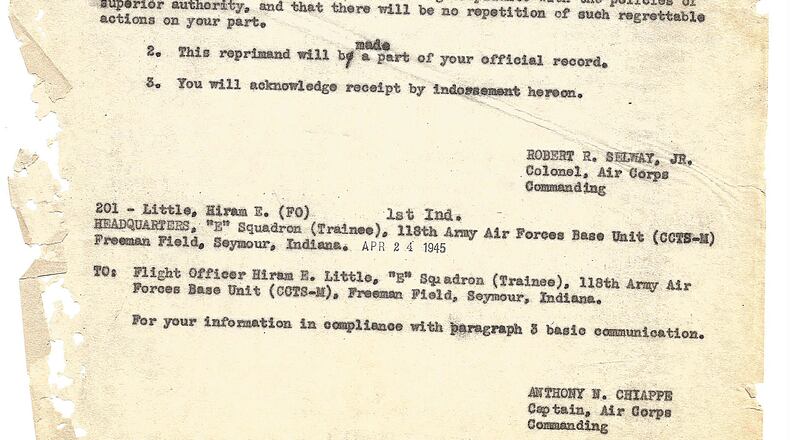You’ve almost surely seen a World War II movie or read a book about the bombing of Pearl Harbor or about the invasion of Normandy on D-Day. Those events in 1941 and 1944 have become etched in Americans’ minds. But here are a few stories about events that took place near the end of the war in 1945, or after the war, that have never managed to make the big screen or paperback in any significant way.
FREEMAN FIELD MUTINY
As the Tuskegee Airmen were making a name for themselves overseas fighting for the Allied cause, the men of the all-black 477th Bombardment Group were making their own history in Seymour, Ind.
At Freeman Army Airfield, a U.S. Army Air Forces base, new rules were enacted by Col. Robert R. Selway Jr. that prohibited black airmen from entering the all-white officers club. After several strategic meetings, a few black officers decided to test the new segregated regulations on April 5, 1945. While they were initially denied admission, Marsden Thompson, Shirley Clinton and Roger Terry eventually made their way inside.
Similar incidents occurred the next day. Within a 24-hour span, 61 African-American officers were detained
On April 9, a meeting was called to reaffirm the new regulations and have the black officers sign an official document. A total of 101 refused, so they were placed under arrest in quarters, then sent to Godman Field in Kentucky to await trial.
About two weeks later, the arrested officers were released and the charges were dropped, but each of them received a reprimand that was placed in his personnel file. One of those men was Hiram Little, who lives in Atlanta.
Thompson, Clinton and Terry, however, were court-martialed. While Thompson and Clinton were acquitted on all counts, Terry was convicted of offering violence and fined $150. He also suffered loss of rank and received a dishonorable discharge.
In 1995, the Air Force overturned the verdict against Terry and vindicated the actions of the black airmen, removing the reprimands from their military records.
THE JAPANESE HOLDOUTS
Almost 30 years after the war officially ended in the Pacific, the most famous of the so-called Japanese holdouts finally gave up in 1974.
Hiroo Onoda, an intelligence officer, was sent to the Philippine island of Lubang in 1944 and given orders not to surrender under any circumstances. When Allied troops captured Lubang in 1945, the lieutenant and three of his fellow soldiers retreated to the jungle.
They continued to fight for several years, killing about 30 Filipinos. One of his companions surrendered in 1950, and the other two were eventually killed.
The Japanese attempted on several occasions to contact Onoda, sending search parties and dropping leaflets telling him the war was over – but he refused to believe it.
Finally in March 1974, Onoda’s former commander traveled to the island and convinced him the war was indeed over. Onoda was 51.
A few months later, Taiwanese-born Teruo Nakamura officially became the last Japanese soldier to surrender after his hut on Morotai Island in Indonesia was spotted from a plane. The public’s response in Japan was different from when Onoda returned for several reasons: there were questions about his nationality, he spoke neither Japanese nor Chinese, and he was only a private. Thus, Onoda often is cited as the last holdout.
LIVING IN THE USA
His name was Dennis Whiles; at least that’s what his family thought. He lived quietly in the United States for years after World War II ended, never telling a soul who he really was.
His real name was Georg Gaertner and he was a German soldier who had been captured by Allied troops in Tunis in 1943 and sent to a prisoner of war camp in Deming, N.M. He escaped from the camp near the end of the war and created a new identity because he was afraid of being turned over to the Russians, who occupied his hometown of Schweidnitz at the time.
Gaertner was never caught by U.S. authorities, despite the fact his FBI wanted posters adorned many post offices. Living mostly in California, he worked as a laborer, married an American woman who had two children, perfected his English and obtained a Social Security card.
At the age of 64, he finally revealed his identity to Bryant Gumbel on the “Today” show in 1985. The U.S. government never charged him with any crimes and did not attempt to deport him.
Gaertner became a U.S. citizen in 2009, four years before his death.
SURPLUS OF PURPLE HEARTS
In 2000, the U.S. government ordered a new supply of 9,000 Purple Hearts, the decoration awarded to American servicemen wounded in battle or killed in action. The old supply had been manufactured in the 1940s in anticipation of an Allied invasion of Japan.
U.S. military leaders forecast needing hundreds of thousands of Purple Hearts – or more – for what likely would have been a costly, prolonged assault. Some experts estimate an invasion would have lasted until at least 1947 and cost the U.S. up to 1 million casualties.
The invasion never took place after the U.S. dropped atomic bombs on Hiroshima and Nagasaki, prompting the Japanese to surrender.
That meant the U.S. had an abundance of Purple Hearts to bestow to young soldiers or to grieving families during military conflicts over the next 50 years. As of 1985, the Defense Logistics Agency said it still had about 120,000 refurbished Purple Hearts from the World War II era. Many of them were sent to military depots, units and hospitals between 1985 and 1999.
Few of those recipients through the years probably knew those Purple Hearts were intended for their fathers or grandfathers.
SITTING ON A SCOOP
In today’s world when news breaks constantly on Twitter, Facebook and online, and everyone around the world sees it instantly, it’s hard to fathom how news about the end of hostilities in Europe during World War II remained suppressed for as long as it did.
In May 1945, with Germany close to defeat, the command of the Allied Expeditionary Forces selected 17 news correspondents from around the world to witness the surrender and report it. The group, which flew to Reims, France, included few American journalists and not one reporter from a U.S. newspaper – only members of wire services or syndicates.
The catch? In order to approve the unprecedented access, the military leaders demanded the news be embargoed. There would be no scoops.
The German surrender took place in Reims on May 7. The blackout was intended to last until the next evening so the news could be simultaneously announced in Paris, London, Moscow and Washington.
But Associated Press chief correspondent Edward Kennedy decided this type of news couldn’t wait. So upon landing back in Paris, he went to the censors and announced he was breaking the embargo. He called the AP’s London bureau and dictated his lead.
Within minutes, the world knew everything.
As a result, the top brass temporarily suspended the AP’s filing facilities throughout Europe, more than 50 of Kennedy’s fellow correspondents signed a petition against him, and AP’s president, Robert McLean, issued an apology. When Kennedy wouldn’t admit guilt, he was fired.
In 2012, the AP formally apologized to Kennedy, who died in a car crash in 1963.
MYSTERY OF HITLER’S REMAINS
Adolf Hitler died April 30, 1945. That much we know for sure. It is widely believed he died of a gunshot wound, but poison also could have contributed to his death.
We also know he married Eva Braun earlier that day, and that she died with him from a cyanide capsule. Their bodies were discovered near their emergency bunker in Berlin and taken to a garden, where they were doused with gas and set on fire by German soldiers. The Russian Army discovered them in an artillery shell crater days later.
In the ensuing year, the corpses were reportedly moved several times, finally buried at a Soviet garrison in Magdeburg, Germany, in 1946.
Years later, a top Russian security official confirmed that the bodies were exhumed from the garrison burial site, destroyed and tossed into an unnamed stream near Biederitz, Germany on April 4, 1970. The task was performed by a three-man team on the orders of KGB chief Yuri Andropov, who later became the leader of the Soviet Union. The team worked in secrecy, fearing that a Hitler burial site would become a Nazi shrine.
All that is left of Hitler’s remains are fragments of his jawbone and skull, items that are kept in an undisclosed location in Russia. DNA testing recently revealed the bones did not belong to Hitler, but were of female origin. Russian officials, however, contend they are legitimate.
The mystery continues.
Sources:
“Heroes in War – Heroes at Home; First Top Guns,” by Zellie Rainey Orr
History.com
Jakarta Post
Los Angeles Times
CNN.com
History News Network
Stars and Stripes
Associated Press
TheConversation.com
Daily Mail
About the Author
Keep Reading
The Latest
Featured




